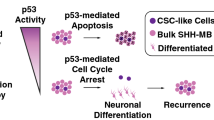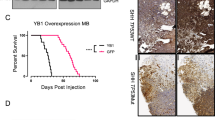Abstract
Medulloblastoma (MB) is the most common brain malignancy in children. Whole neural axis irradiation is the treatment of choice, but it often results in long-term neurocognitive and developmental impairment. Only insights into MB biology will lead to improved therapeutic outcome. Wingless (WNT) signalling deregulation occurs in up to 25% of sporadic tumors, but the specific role of nuclear β-catenin and its involvement in the radioresponse remains unsettled. Therefore we studied the γ-radiation response of two MB cell lines from cellular and molecular points of view. Our data show that the p53 wild-type cell line is more sensitive to ionizing radiations (IR) than the p53 mutated line, but apoptosis is also induced in p53-mutated cells, suggesting an alternative p53-independent mechanism. In addition, this study is the first to demonstrate that γ-rays trigger the WNT system in our in vitro models. Further studies are required to test if this could explain the radiosensitivity of MB and the favorable prognostic value of nuclear β-catenin in this tumor.







Similar content being viewed by others
References
Eberhart CG, Kepner JL, Goldthwaite PT et al (2002) Histopatologic grading of medulloblastomas: a pediatric oncology group study. Cancer 94:552–560. doi:10.1002/cncr.10189
Kleihues P, Luis DN, Scheithauer BW et al (2002) The WHO classification of tumors of the nervous system. J Neuropathol Exp Neurol 61:215–225
Ellison D (2002) Classifying the medulloblastoma: insights from morphology and molecular genetics. Neuropathol Appl Neurobiol 28:257–280. doi:10.1046/j.1365-2990.2002.00419.x
Gilbertson RJ (2004) Medulloblastoma: signaling a change in treatment. Lancet Oncol 5:209–218. doi:10.1016/S1470-2045(04)01424-X
Giangaspero F, Wellek S, Masuoka J et al (2006) Stratification of medulloblastoma on the basis of histopathological grading. Acta Neuropathol 112:5–12. doi:10.1007/s00401-006-0064-x
Koch A, Hrychyk A, Hartmann W et al (2007) Mutations of the Wnt antagonist AXIN2 (Conductin) result in TCF-dependent transcription in medulloblastomas. Int J Cancer 121:284–291. doi:10.1002/ijc.22675
Eberhart CG, Tuhan T, Burger PC (2000) Nuclear localization and mutation of β-catenin in medulloblastomas. J Neuropathol Exp Neurol 59:333–337
Clifford SC, Lusher ME, Lindsey JC et al (2006) WNT/Wingless pathway activation and chromosome 6 loss characterize a distinct molecular sub-group of medulloblastomas associated with a favorable prognosis. Cell Cycle 5:2666–2670
Ellison DW, Clifford SC, Gajjar A et al (2003) What’s new in neuro-oncology? Recent advances in medulloblastoma. Eur J Paediatr Neurol 7:53–66. doi:10.1016/S1090-3798(03)00014-X
Cadigan KM, Liu YI (2006) Wnt signaling: complexity at the surface. J Cell Sci 119:395–402. doi:10.1242/jcs.02826
Marino S (2005) Medulloblastoma: developmental mechanisms out of control. Trends Mol Med 11:17–22. doi:10.1016/j.molmed.2004.11.008
Ellison DW, Onilude OE, Lindsey JC, United Kingdom Children’s Cancer Study Group Brain Tumour Committe et al (2005) β-Catenin status predicts a favorable outcome in childhood medulloblastoma: the United Kingdom Children’s Cancer Study Group Brain Tumour Committee. J Clin Oncol 23:7951–7957. doi:10.1200/JCO.2005.01.5479
Woodward WA, Chen M, Behbod F et al (2007) WNT/β-catenin mediates radiation resistance of mouse mammary progenitor cells. Proc Natl Acad Sci USA 104:618–623. doi:10.1073/pnas.0606599104
Rodningen OK, Borresen-Dale AL, Alsner J et al (2008) Radiation-induced gene expression in human subcutaneous fibroblasts is predictive of radiation-induced fibrosis. Radiother Oncol 86:314–320. doi:10.1016/j.radonc.2007.09.013
Siu IM, Lal A, Blakenship JR et al (2003) c-Myc promoter activation in medulloblastoma. Cancer Res 63:4773–4776
Gassler N, Herr I, Keith M et al (2004) Wnt-signaling and apoptosis after neoadjuvant short-term radiotherapy for rectal cancer. Int J Oncol 25:1543–1549
Chen MS, Woodward WA, Behbod F et al (2007) Wnt/beta-catenin mediates radiation resistance of Sca1+ progenitors in an immortalized mammary gland cell line. J Cell Sci 120:468–477. doi:10.1242/jcs.03348
Dihlmann S, Siermann A, von Knebel Doeberitz M (2001) The nonsteroidal anti-inflammatory drugs aspirin and indomethacin attenuate β-catenin/TCF-4 signaling. Oncogene 20:645–653. doi:10.1038/sj.onc.1204123
Ricciardiello L, Baglioni M, Giovannini C et al (2003) Induction of chromosomal instability in colonic cells by the human polyomavirus JC virus. Cancer Res 63:7256–7262
Nusse M, Beisker W, Hoffmann C et al (1990) Flow cytometric analysis of G1- and G2/M-phase subpopulations in mammalian cell nuclei using side scatter and DNA content measurements. Cytometry 11:813–821. doi:10.1002/cyto.990110707
Salaroli R, Russo A, Ceccarelli C et al (2007) Intracellular distribution of beta-catenin in human medulloblastoma cell lines with different degree of neuronal differentiation. Ultrastruct Pathol 31:33–44. doi:10.1080/01913120601169501
Jozwiak J, Grajkowska W, Wlodarski P (2007) Pathogenesis of medulloblastoma and current treatment outlook. Med Res Rev 27:869–890. doi:10.1002/med.20088
Kumar KS, Sonnemann J, Hong le TT et al (2007) Histone deacetylase inhibitors, but not vincristine, cooperate with radiotherapy to induce cell death in medulloblastoma. Anticancer Res 27:465–470
Whelan HT, Krouwer HG, Schmidt MH et al (1998) Current therapy and perspectives in the treatment of Medulloblastoma. Pediatr Neurol 18:103–115. doi:10.1016/S0887-8994(97)00221-X
Cervoni L, Cantore G (1995) Medulloblastoma in pediatric age: a single institution review of prognostic factors. Childs Nerv Syst 11:80–85. doi:10.1007/BF00303809
Hoppe-Hirsch E, Brunet L, Laroussinie F et al (1995) Intellectual outcome in children whit malignant tumors of the posterior fossa: influence of the field of irradiation and quality of surgery. Childs Nerv Syst 11:340–346. doi:10.1007/BF00301666
Dennis M, Spiegler BJ, Htherington CR et al (1996) Neuropsychological sequela of the treatment of children with medulloblastoma in infants. J Neurooncol 29:91–101. doi:10.1007/BF00165522
Criswell T, Leskov K, Miyamoto S et al (2003) Transcription factors activated in mammalian cells after clinically relevant doses of ionizing radiation. Oncogene 22:5813–5827. doi:10.1038/sj.onc.1206680
Belka C (2006) The fate of irradiated tumor cells. Oncogene 25:969–970. doi:10.1038/sj.onc.1209175
Gudkov AV, Komarova EA (2003) The role of p53 in determining sensitivity to radiotherapy. Nat Rev Cancer 3:117–129. doi:10.1038/nrc992
Willers H, Dahm-Daphi J, Powell SN (2004) Repair of radiation damage to DNA. Br J Cancer 90:1297–1301. doi:10.1038/sj.bjc.6601729
Zhou BB, Elledge SJ (2000) The DNA damage response: putting checkpoints in perspective. Nature 408:433–439. doi:10.1038/35044005
Niida H, Nakanishi M (2006) DNA damage checkpoints in mammals. Mutagenesis 21:3–9. doi:10.1093/mutage/gei063
Perry ME (2004) MDM2 in response to radiation. Mol Cancer Res 2:9–19
Chang BD, Broude EV, Dokmanovic M et al (1999) A senescence-like phenotype distinguishes tumor cells that undergo terminal proliferation arrest after exposure to anticancer agents. Cancer Res 59:3761–3767
Kemp CJ, Sun S, Gurley KE (2001) p53 induction and apoptosis in response to radio- and chemotherapy in vivo is tumor-type-dependent. Cancer Res 61:327–332
Roninson IB, Broude EV, Chang BD (2001) If not apoptosis, then what? Treatment-induced senescence and mitotic catastrophe in tumor cells. Drug Resist Update 4:303–313. doi:10.1054/drup. 2001.0213
Gottardo NG, Gajjar A (2006) Current therapy for medulloblastoma. Curr Treat Options Neurol 8:319–334. doi:10.1007/s11940-006-0022-x
Oren M (2003) Decision making by p53: life, death and cancer. Cell Death Differ 10:431–442. doi:10.1038/sj.cdd.4401183
Appella E, Anderson CW (2001) Post-translational modifications and activation of p53 by genotoxic stresses. Eur J Biochem 268:2764–2772. doi:10.1046/j.1432-1327.2001.02225.x
Maya R, Balass M, Kim ST et al (2001) ATM-dependent phosphorylation of Mdm2 on serine 395: role in p53 activation by DNA damage. Genes Dev 15:1067–1077. doi:10.1101/gad.886901
Offer H, Erez N, Zurer I et al (2002) The onset of p53-dependent DNA repair or apoptosis is determined by the level of accumulated damaged DNA. Carcinogenesis 23:1025–1032. doi:10.1093/carcin/23.6.1025
Frank AJ, Hernan R, Hollander A et al (2004) The TP53-ARF tumor suppressor pathway is frequently disrupted in large/cell anaplastic medulloblastoma. Brain Res Mol Brain Res 121:137–140. doi:10.1016/j.molbrainres.2003.11.016
Li Y, He L, Bruce A et al (2006) p14ARF inhibits the growth of p53 deficient cells in a cell-specific manner. Biochim Biophys Acta 1763:787–796. doi:10.1016/j.bbamcr.2006.04.011
Iwai A, Marusawa H, Matsuzawa S et al (2004) Siah-1L, a novel transcript variant belonging to the human S family of proteins, regulates beta catenin activity in a p53-dependent manner. Oncogene 23:7593–7560. doi:10.1038/sj.onc.1208016
Sadot E, Geiger B, Oren M et al (2001) Down-regulation of beta-catenin by activated p53. Mol Cell Biol 21:6768–6781. doi:10.1128/MCB.21.20.6768-6781.2001
Jüllig M, Zhang WV, Ferreira A et al (2006) MG132 induced apoptosis is associated with p53-independent induction of pro-apoptotic Noxa and transcriptional activity of beta-catenin. Apoptosis 11:627–641. doi:10.1007/s10495-006-4990-9
van Gijn ME, Snel F, Cleutjens JP et al (2001) Overexpression of components of the Frizzled-Dishevelled cascade results in apoptotic cell death, mediated by beta-catenin. Exp Cell Res 265:46–53. doi:10.1006/excr.2001.5174
Tell S, Yi H, Jockovich ME et al (2006) The Wnt signaling pathway has tumor suppressor properties in retinoblastoma. Biochem Biophys Res Commun 349:261–269. doi:10.1016/j.bbrc.2006.08.044
Kim K, Pang KM, Evans M et al (2000) Overexpression of beta-catenin induces apoptosis independent of its transactivation function with LEF-1 or the involvement of major G1 cell cycle regulators. Mol Biol Cell 11:3509–3523
Olmeda D, Castel S, Vilaro S et al (2003) β-catenin regulation during the cell cycle: implications in G2/M and apoptosis. Mol Biol Cell 14:2844–2860. doi:10.1091/mbc.E03-01-0865
Abramova MV, Pospelova TV, Nikulenkov FP et al (2006) G1/S arrest induced by histone deacetylase inhibitor sodium butyrate in E1A + Ras-transformed cells is mediated through down-regulation of E2F activity and stabilization of beta-catenin. J Biol Chem 281:21040–21051. doi:10.1074/jbc.M511059200
Damalas A, Kahan S, Shtutman M et al (2001) Deregulated beta-catenin induces a p53- and ARF-dependent growth arrest and cooperates with Ras in trasformation. EMBO J 20:4912–4922. doi:10.1093/emboj/20.17.4912
Acknowledgments
This research project was partially supported by PRIN 2002 and 2006 and MIUR ex60% grants. We acknowledge L. Montanaro for valuable discussion.
Author information
Authors and Affiliations
Corresponding author
Rights and permissions
About this article
Cite this article
Salaroli, R., Di Tomaso, T., Ronchi, A. et al. Radiobiologic response of medulloblastoma cell lines: involvement of β-catenin?. J Neurooncol 90, 243–251 (2008). https://doi.org/10.1007/s11060-008-9659-5
Received:
Accepted:
Published:
Issue Date:
DOI: https://doi.org/10.1007/s11060-008-9659-5




